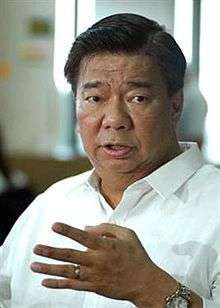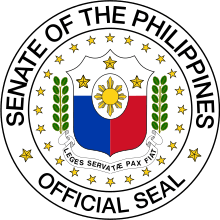President of the Senate of the Philippines
| President of the Senate of the Philippines Pangulo ng Senado ng Pilipinas | |
|---|---|
|
| |
| Style |
Mr. President (When presiding over Senate) The Honorable (Formal) |
| Appointer | Elected by the Senate of the Philippines |
| Inaugural holder | Manuel L. Quezon |
| Formation | October 16, 1916 |
| Succession | Second in the Presidential Line of Succession |
| Website | Senate |
 |
| This article is part of a series on the politics and government of the Philippines |
|
Legislature
|
|
Constitutional Commissions |
The President of the Senate of the Philippines (Filipino: Pangulo ng Senado ng Pilipinas) or more popularly known as the Senate President, is the presiding officer and the highest ranking-official of the Senate of the Philippines and third highest and most powerful official in the Government of the Philippines. He/she is elected by the entire body to be their leader. The current Senate President of the 17th Congress of the Philippines is Aquilino Pimentel III, who was elected on July 25, 2016.
The Senate President is second in line in succession for the presidency, behind the Vice President of the Philippines and in front of the Speaker of the House of Representatives of the Philippines.
Election
The Senate President is elected by the majority of the Members of the Senate from among themselves; Since there are 24 Senators, thirteen votes (13) are needed to win the Senate Presidency, including any vacant seats or senators not attending the session. Although Senate presidents are elected at the start of each Congress, there had been numerous instances of Senate coups in which a sitting Senate President is unseated in the middle of session. Term-sharing agreements among Senators who are both eyeing the position of the Senate President also played a role in changing the leadership of the Senate, but in a smooth manner, the peaceful transition of power and this was done two times on 1999 and on 2006.
Unlike most Senate Presidents that are the symbolic presiding officers of the upper house, the Senate President of the Philippines wields considerate power by influencing the legislative agenda and has the ability to vote not just in order to break ties, although the Senate President is traditionally the last senator to vote. A tied vote, therefore, means that the motion is lost, and that the Senate President cannot cast a tie-breaking vote since that would mean that the presiding officer would have had voted twice.
Powers and duties
According to the Rule 3 of the Rules of the Senate, the Senate President has the powers and duties to:
- To preside over the sessions of the Senate on the days and at the hours designated by it; to call the Senate to order and, if there is a quorum, to order the reading of the Journal of the preceding session and, after the Senate shall have acted upon it, to dispose of the matters appearing in the Order of Business in accordance with the Rules;
- To decide all points of order;
- To sign all measures, memorials, joint and concurrent resolutions; issue warrants, orders of arrest, subpoena and subpoena duces tecum;
- To see to it that all resolutions of the Senate are complied with;
- To have general control over the session hall, the antechambers, corridors and offices of the Senate;
- To maintain order in the session hall, the antechambers, corridors and in the offices of the Senate, and whenever there is disorder, to take appropriate measures to quell it;
- To designate an Acting Sergeant-at-Arms, if the Sergeant-at-Arms resigns, is replaced or becomes incapacitated;
- To appoint the subordinate personnel of the Senate in conformity with the provisions of the General Appropriations Act;
- To dismiss any employee for cause, which dismissal in the case of permanent and classified employees shall be in conformity with the Civil Service Law; and
- To diminish or increase the number of authorized personnel by consolidating or separating positions or items whenever the General Appropriations Act so authorizes and the total amount of salaries or allocations does not exceed the amount earmarked therein.
The Senate President is also the ex officio chairman of the Commission on Appointments, a constitutional body within the Congress that has the sole power to confirm all appointments made by the President of the Philippines . Under Section 2 of Chapter 2 of the Rules of the Commission on Appointments, the powers and duties of the Senate President as its Ex-Officio Chairman are as follows:
- to issue calls for the meetings of the Commission;
- to preside at the meetings of the Commission;
- to preserve order and decorum during the session and, for that purpose, to take such steps as may be convenient or as the Commission may direct;
- to pass upon all questions of order, but from his decision, any member may appeal to the Commission; and,
- to execute such decisions, orders, and resolutions as may have been approved by the Commission.
And if other impeachable officers other than the President such as the Ombudsman is on an impeachment trial, the Senate President is the presiding officer and shall be the last to vote on the judgment on such cases according to the Senate Rules of Procedure in Impeachment Trials the Senate adopted on March 23, 2011.
In the Senate, he supervises the committees and attended its hearings and meetings if necessary and such committee reports are being submitted to his/her office.
List of Senate Presidents
The Senate was created on 1916 with the abolition of the Philippine Commission as the upper house with the Philippine Assembly as the lower house. The Senate and the House of Representatives comprised the Philippine Legislature (PL). Representation was by senatorial district; Manuel L. Quezon was elected Senator from the now-defunct 5th Legislative District.
All Senators from 1941 onwards were elected at-large, with the whole Philippines as one constituency.
| # | Senate President | Party | Legislature | Start of service | End of service | Era | |
|---|---|---|---|---|---|---|---|
| 1 | Manuel L. Quezon, Sr. | Nacionalista | 4th Philippine Legislature | August 29, 1916 | 1919 | Insular Government | |
| 5th Philippine Legislature | 1919 | 1922 | |||||
| 6th Philippine Legislature | 1922 | 1925 | |||||
| 7th Philippine Legislature | 1925 | 1928 | |||||
| 8th Philippine Legislature | 1928 | 1931 | |||||
| 9th Philippine Legislature | 1931 | 1934 | |||||
| 10th Philippine Legislature | 1934 | November 15, 1935 | |||||
|
Commonwealth | ||||||
| 2 | Manuel Roxas | Nacionalista (Liberal wing) |
1st Commonwealth Congress | July 9, 1945 | May 25, 1946 | ||
| 3 | José Avelino | Liberal | 2nd Commonwealth Congress | May 25, 1946 | July 4, 1946 | ||
| 1st Congress | July 5, 1946 | February 21, 1949 | Third Republic | ||||
| 4 | Mariano Jesús Cuenco | Liberal | February 21, 1949 | December 30, 1949 | |||
| 2nd Congress | December 30, 1949 | December 30, 1951 | |||||
| 5 | Quintin Paredes | Liberal | March 5, 1952 | April 17, 1952 | |||
| 6 | Camilo Osías | Nacionalista | April 17, 1952 | April 30, 1952 | |||
| 7 | Eulogio Rodriguez, Sr. | Nacionalista | April 30, 1952 | April 17, 1953 | |||
| 8 | Camilo Osías (2nd time) | Liberal | April 17, 1953 | April 30, 1953 | |||
| 9 | Jose Zulueta | Liberal | April 30, 1953 | November 30, 1953 | |||
| 10 | Eulogio Rodriguez, Sr. (2nd time) | Nacionalista | November 30, 1953 | December 30, 1953 | |||
| 3rd Congress | January 25, 1954 | December 30, 1957 | |||||
| 4th Congress | January 27, 1958 | December 30, 1961 | |||||
| 5th Congress | January 22, 1962 | April 5, 1963 | |||||
| 11 | Ferdinand Marcos, Sr. | Liberal | April 5, 1963 | April 1964 | |||
| Nacionalista | April 1964 | December 30, 1965 | |||||
| 12 | Arturo Tolentino | Nacionalista | 6th Congress | January 17, 1966 | January 26, 1967 | ||
| 13 | Gil Puyat | Nacionalista | January 26, 1967 | December 30, 1969 | |||
| 7th Congress | January 26, 1970 | September 23, 1972 | |||||
|
Fourth Republic | ||||||
| 14 | Jovito Salonga | Liberal | 8th Congress | July 27, 1987 | January 18, 1992[1] | Fifth Republic | |
| 15 | Neptali Gonzales | LDP | January 18, 1992[2] | June 30, 1992 | |||
| 9th Congress | July 27, 1992 | January 18, 1993 | |||||
| 16 | Edgardo Angara | LDP | January 18, 1993 | June 30, 1995 | |||
| 10th Congress | July 24, 1995 | August 28, 1995 | |||||
| 17 | Neptali Gonzales (2nd time) | LDP | August 29, 1995 | October 10, 1996 | |||
| 18 | Ernesto Maceda, Sr. | NPC | October 10, 1996 | January 26, 1998 | |||
| 19 | Neptali Gonzales (3rd time) | LDP | January 26, 1998 | June 30, 1998 | |||
| 20 | Marcelo Fernan | LDP | 11th Congress | July 27, 1998 | June 28, 1999 | ||
| 21 | Blas Ople | LAMP | June 29, 1999 | July 12, 2000[3] | |||
| 22 | Franklin Drilon | LAMP | July 12, 2000[4] | November 13, 2000 | |||
| 23 | Aquilino Pimentel, Jr. | PDP-Laban | November 13, 2000 | June 30, 2001 | |||
| 24 | Franklin Drilon (2nd time) | Independent | 12th Congress | July 23, 2001 | November 24, 2003 | ||
| Liberal | November 24, 2003 | June 30, 2004 | |||||
| 13th Congress | July 24, 2004 | July 24, 2006 | |||||
| 25 | Manny Villar | Nacionalista | July 24, 2006 | June 30, 2007 | |||
| 14th Congress | July 23, 2007 | November 17, 2008 | |||||
| 26 | Juan Ponce Enrile | PMP | November 17, 2008 | June 30, 2010 | |||
| 15th Congress | July 26, 2010 | June 5, 2013 | |||||
| — | Jinggoy Estrada (Acting) |
PMP | June 5, 2013 | June 30, 2013 | |||
| 27 | Franklin Drilon (3rd time) | Liberal | 16th Congress | July 22, 2013 | June 30, 2016 | ||
| 28 | Aquilino Pimentel III | PDP-Laban | 17th Congress | July 25, 2016 | present | ||
Timeline

Living former Senate Presidents
Currently there are seven living former Senate Presidents:
- Living Former Senate Presidents
 Edgardo Angara (LDP), served 1993-1995
Edgardo Angara (LDP), served 1993-1995 Franklin Drilon (LP), served 2000, 2001-2006, 2013-2016
Franklin Drilon (LP), served 2000, 2001-2006, 2013-2016 Aquilino Pimentel, Jr. (PDP-Laban), served 2000-2001
Aquilino Pimentel, Jr. (PDP-Laban), served 2000-2001 Manny Villar (NP), served 2006-2008
Manny Villar (NP), served 2006-2008 Jinggoy Estrada (PMP), served 2013 (acting)
Jinggoy Estrada (PMP), served 2013 (acting)
Legend: Boldface means still an incumbent Senator.

